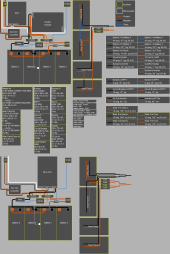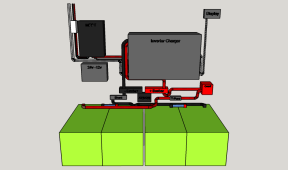Siber
New Member
- Joined
- Oct 20, 2022
- Messages
- 6
I'm trying for a 24V system with a 3kWh inverter, into a 2000 Fleetwood Bounder 32' motorhome with 30A shore power.
I'll want it to switch between solar and shore power, and maybe the engine too but that's not a high priority since the vehicle will most likely be sitting most of the time.
I have some parts and a pretty good idea of what I basically want, but there's plenty more to get and I'm sure there will be many changes to my half-baked plan as I progress.
Here's my diagram
and my 3D Sketchup model
 drive.google.com
drive.google.com
I'm not sure if I want to do the all-in-one thing or separate components. I think I'd like to do them separately, if it's not too expensive, so no Victron for this system
For an all-in-one, I was considering the Easun/Powland ISolar MLV3KW-U, but it seems it's too limited, so now I'm considering the Sigineer Power M3024NC.
For a separate component system, I'm considering these for the MPPT,
-GCSOAR 60A, GCIT6024(10Li) +WIFI Cloud Box
-HQST 60A, HCC60HTR-PL-US
-OAE 60A, the blue one
-Easun Power 80A, MPPT4880
these for the inverter,
-XWJNE 24V 3000W
-WZRELB 24V 3000W, VC300024U5WD-1
-WZRELB 24V 3500W RBP350024VCRT
-VEVOR 24V 3000W or 3500W
and these for the transfer switch.
-MOES Dual Power Controller 50A, ATS-11KW
-Spartan Power 50A, SP-TS4500PLUS
-PowerMax 50A, PMTS
-Go Power 30A, TS-30
Or instead an inverter charger like the Ampinvt FTS - 3000W24V or Sigineer Power APC3024NC.
Other than that, I'll also have to add a 24V to 12V DC converter and sort out the wiring and fuses, but that's basically where I'm at now.
I was considering two inverters, to limit no-load draw, but the Ampinvt 3000w inverter charger seems to be around the same as smaller inverters at around an amp or less, so maybe, maybe not.
I'm also not exactly sure what to do with the DC Out on the MPPT.
The 24V to 12V converter also has me stumped as to where to hook it into, if at all.
There is a single lead acid house battery that is installed in the rv, so maybe wire it to that or to the engine battery/alternator somehow?
I was at first thinking 2 AWG would be fine for the battery and inverter connections, but now I'm not certain and maybe it might be best to use 4/0, or maybe that's too big and something in between would be best?
Thank you for any help and insights into what I might be doing wrong, or right :D
I'll want it to switch between solar and shore power, and maybe the engine too but that's not a high priority since the vehicle will most likely be sitting most of the time.
I have some parts and a pretty good idea of what I basically want, but there's plenty more to get and I'm sure there will be many changes to my half-baked plan as I progress.
Here's my diagram
and my 3D Sketchup model
Solar1old.skp
 drive.google.com
drive.google.com
I'm not sure if I want to do the all-in-one thing or separate components. I think I'd like to do them separately, if it's not too expensive, so no Victron for this system
For an all-in-one, I was considering the Easun/Powland ISolar MLV3KW-U, but it seems it's too limited, so now I'm considering the Sigineer Power M3024NC.
For a separate component system, I'm considering these for the MPPT,
-GCSOAR 60A, GCIT6024(10Li) +WIFI Cloud Box
-HQST 60A, HCC60HTR-PL-US
-OAE 60A, the blue one
-Easun Power 80A, MPPT4880
these for the inverter,
-XWJNE 24V 3000W
-WZRELB 24V 3000W, VC300024U5WD-1
-WZRELB 24V 3500W RBP350024VCRT
-VEVOR 24V 3000W or 3500W
and these for the transfer switch.
-MOES Dual Power Controller 50A, ATS-11KW
-Spartan Power 50A, SP-TS4500PLUS
-PowerMax 50A, PMTS
-Go Power 30A, TS-30
Or instead an inverter charger like the Ampinvt FTS - 3000W24V or Sigineer Power APC3024NC.
Other than that, I'll also have to add a 24V to 12V DC converter and sort out the wiring and fuses, but that's basically where I'm at now.
I was considering two inverters, to limit no-load draw, but the Ampinvt 3000w inverter charger seems to be around the same as smaller inverters at around an amp or less, so maybe, maybe not.
I'm also not exactly sure what to do with the DC Out on the MPPT.
The 24V to 12V converter also has me stumped as to where to hook it into, if at all.
There is a single lead acid house battery that is installed in the rv, so maybe wire it to that or to the engine battery/alternator somehow?
I was at first thinking 2 AWG would be fine for the battery and inverter connections, but now I'm not certain and maybe it might be best to use 4/0, or maybe that's too big and something in between would be best?
Thank you for any help and insights into what I might be doing wrong, or right :D
Attachments
Last edited:




